Table of Contents
Solar Curriculum: Overview
This curriculum teaches the science behind photovoltaic solar power and the design skills needed to use it practically.
The full curriculum takes a club from the very basics of building a small solar-powered lamp to designing a full-scale solar system to power all or part of a school, medical center or home in their community. This book contains the first 7 lessons, in which students design and build their own solar panel and use it to power a rechargeable lamp or other small device.
The lessons are intended for a club of around 10-20 students, with weekly (or more frequently) 1.5-2hr meetings. The students begin by experimenting with solar cells and finding out about their behaviour, then design and build their own panel and charging circuit to power a rechargeable solar lamp.
After this small section of the curriculum, the main project begins - building a large-scale solar panel system to power a building in your community. This could be a school, a community hall, medical centre, greenhouse, battery-charging station or anywhere solar power could be useful. Let us know if you are interested in doing this project!
In their project, the club will practice all the skills needed to design a large-scale system - brainstorming, estimation, concept selection and system integration. At various points in the curriculum, the club present to their community. First they propose their initial ideas for a system and get community feedback, then present their final design for a system. At the end of the curriculum, the club will have built their own fully-functioning solar power system for their community!
Individual Lesson Overviews
1. Exploring Solar Cells
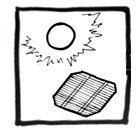 Basic electricity concepts (voltage, current etc) are reviewed. Review of how to use a multimeter. Students experiment with solar cells and discover their properties, then learn about how photovoltaics work.
Basic electricity concepts (voltage, current etc) are reviewed. Review of how to use a multimeter. Students experiment with solar cells and discover their properties, then learn about how photovoltaics work.
2. Design a Panel
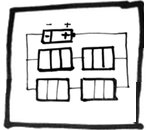 Students review how solar cells behave in series and parallel, and how they can be cut up and recombined to provide different voltages and currents. They then each design their own panel to power a small device (can be anything, but ideally a rechargeable battery for the solar lamp project)
Students review how solar cells behave in series and parallel, and how they can be cut up and recombined to provide different voltages and currents. They then each design their own panel to power a small device (can be anything, but ideally a rechargeable battery for the solar lamp project)
3. Cutting Solar Cells
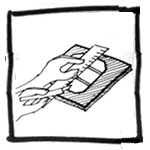 The club learns about solar cells structure, and learns the tricky skill of cutting solar panels! They get some practice at cutting then cut the pieces they need for the panels they designed in the last lesson.
The club learns about solar cells structure, and learns the tricky skill of cutting solar panels! They get some practice at cutting then cut the pieces they need for the panels they designed in the last lesson.
4. Soldering Solar Cells
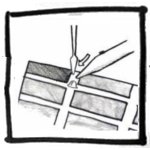 Soldering solar cells is another tricky skill needed to be able to make solar panels. Students practice soldering on bare wires then learn the correct technique for soldering together delicate cells.
Soldering solar cells is another tricky skill needed to be able to make solar panels. Students practice soldering on bare wires then learn the correct technique for soldering together delicate cells.
5. Optics and Lamp Building
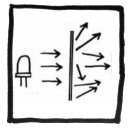 This lesson goes over the other aspects of designing and building a solar lamp - the optics (how to direct or diffuse the light to fit an application) and the physical structure of the lamp. Students then build the structure of their lamps using scrap or found materials.
This lesson goes over the other aspects of designing and building a solar lamp - the optics (how to direct or diffuse the light to fit an application) and the physical structure of the lamp. Students then build the structure of their lamps using scrap or found materials.
6. Lamp Circuit Design

The club reviews basic circuit concepts, then learns about the circuits required to create a battery-charging solar lamp (how to prevent overcharging and overnight discharging). They then design and test their own circuits using simple components.
7. Finishing Lamp
 Students finish any circuit-soldering or lamp-building needed for their solar lamps, then test them out!
Students finish any circuit-soldering or lamp-building needed for their solar lamps, then test them out!
Rest of the Solar Curriculum (not included in this book)
This part of the curriculum goes from a simple lamp device to designing a solar power system for a building or large application. It is still in development, but let us know if your club wants to try it.
- 9. Estimation and Brainstorming 1: Students learn the basics behind estimation - the art of back-of-the-envelope calculations and how to figure out quickly whether a design is feasible or not.
- 10. Estimation and Brainstorming 2: The club turns its new-found estimation skills to the task of coming up with ideas for a large-scale solar system project. Students brainstorm ideas then do some simple calculations to see which ones are technically and financially feasible for their community.
- 11. Presenting to the Community 1: Students summarize their intial design ideas and present them to their community (school, village, town or home) to get feedback for a final design.
- 12. Safety: The club learns about safety rules for working with high-power electricity.
- 13. Lead-Acid Batteries: Students learn how to safely use lead-acid (car) batteries, and how to use them in a solar power system.
- 14. Inverters: Inverters are used to change DC current (produced by solar panels) to AC current (used by many appliances). Students will learn how these work and potentially build one of their own.
- 15. In-Depth System Design: This part of the course covers several weeks; the students learn methods for power system design and use them to make a final design for their solar system.
- 16. Presenting to the Community 2:The students talk to their community again, this time with their final design for their system.
- 17. Build the system:Build the system! Build the physical setup and do testing, as well as designing a schedule for maintenance.